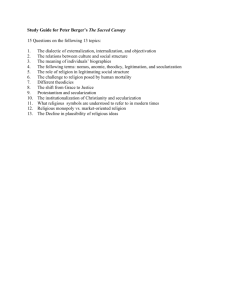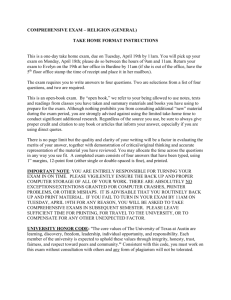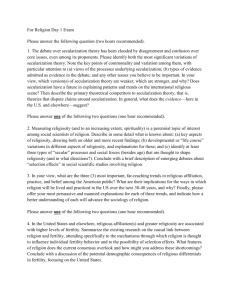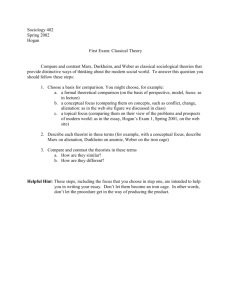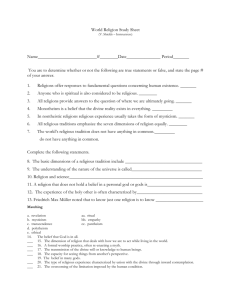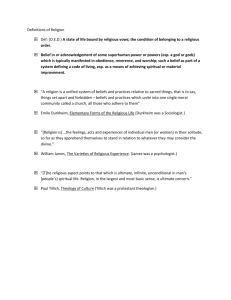Religion
advertisement
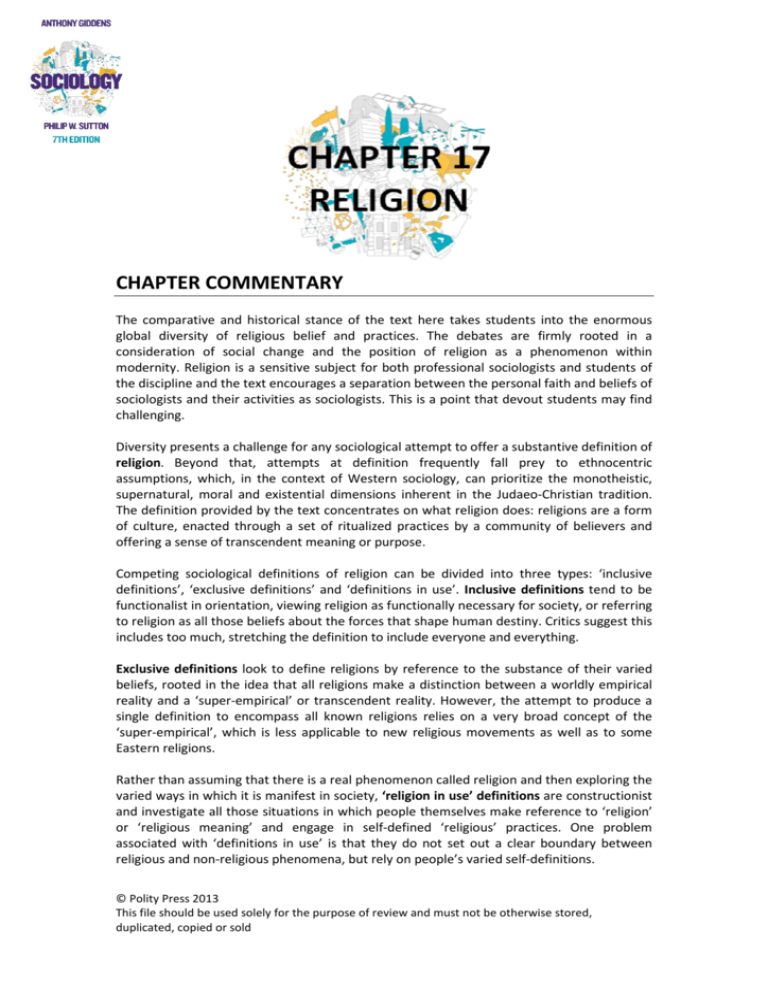
CHAPTER COMMENTARY The comparative and historical stance of the text here takes students into the enormous global diversity of religious belief and practices. The debates are firmly rooted in a consideration of social change and the position of religion as a phenomenon within modernity. Religion is a sensitive subject for both professional sociologists and students of the discipline and the text encourages a separation between the personal faith and beliefs of sociologists and their activities as sociologists. This is a point that devout students may find challenging. Diversity presents a challenge for any sociological attempt to offer a substantive definition of religion. Beyond that, attempts at definition frequently fall prey to ethnocentric assumptions, which, in the context of Western sociology, can prioritize the monotheistic, supernatural, moral and existential dimensions inherent in the Judaeo-Christian tradition. The definition provided by the text concentrates on what religion does: religions are a form of culture, enacted through a set of ritualized practices by a community of believers and offering a sense of transcendent meaning or purpose. Competing sociological definitions of religion can be divided into three types: ‘inclusive definitions’, ‘exclusive definitions’ and ‘definitions in use’. Inclusive definitions tend to be functionalist in orientation, viewing religion as functionally necessary for society, or referring to religion as all those beliefs about the forces that shape human destiny. Critics suggest this includes too much, stretching the definition to include everyone and everything. Exclusive definitions look to define religions by reference to the substance of their varied beliefs, rooted in the idea that all religions make a distinction between a worldly empirical reality and a ‘super-empirical’ or transcendent reality. However, the attempt to produce a single definition to encompass all known religions relies on a very broad concept of the ‘super-empirical’, which is less applicable to new religious movements as well as to some Eastern religions. Rather than assuming that there is a real phenomenon called religion and then exploring the varied ways in which it is manifest in society, ‘religion in use’ definitions are constructionist and investigate all those situations in which people themselves make reference to ‘religion’ or ‘religious meaning’ and engage in self-defined ‘religious’ practices. One problem associated with ‘definitions in use’ is that they do not set out a clear boundary between religious and non-religious phenomena, but rely on people’s varied self-definitions. © Polity Press 2013 This file should be used solely for the purpose of review and must not be otherwise stored, duplicated, copied or sold Religion The section on ‘The sociological study of religion’ then turns to the contribution of the discipline’s own trinity: Marx, Durkheim and Weber. Marx’s assertion of the ideological function of religion is set in the context of his intellectual debt to Feuerbach and his use of the notion of alienation as the attribution of human values and ideals to an alien being, a deity. In contrast to Marx, both Durkheim and Weber devoted a considerable part of their intellectual endeavour to the study of religion. Durkheim’s analysis stresses the role of religion in promoting social cohesion. Religion constructs a distinction between the sacred and the profane, with that which is sacred being set apart from and above the world. Durkheim’s The Elementary Form of the Religious Life is a Classic Study in this chapter. Religion is not just about personal belief but vitally about collective ritual through which group solidarity is maintained and a collective worldview affirmed. Such collective belief is particularly important in the management of social disruption and transition. Unlike Durkheim, Weber based his analysis upon a comparative study of world religions and emphasizes the part religion plays in the transformation of societies. Thus he links the transformation of European societies to capitalism with the cultural conditions created by salvation religions. In assessing these analyses the chapter argues that they need not be incompatible. It is undoubtedly true, as Marx asserted that religion has been used as a tool by the powerful to oppress other social groups. Equally, examples abound concerning the unsettling and transformative impact of religion as emphasized by Weber. Durkheim’s major contribution is seen to be his emphasis upon the social importance of religious rituals. Whilst religious beliefs and organizations continue to play an important part in the social life of many societies, sociologists point to the diminution of their influence over various spheres of social life, and they call this secularization. Three dimensions of secularization are identified: decline in membership of religious organizations, decline in the broader social influence of religious organizations and decline in religiosity – i.e. the levels of religious belief. ‘Believing without belonging’ and ‘vicarious religion’ (where a small, active minority perform religious activities on behalf of and with the tacit approval of the non-active majority) are two characterizations of religion today suggested by Grace Davie. Maffesoli theorizes that, although traditional, national religions may be in decline, people in large urban areas increasingly live in the ‘time of the tribes’, and that the continual creation of neo-tribes demonstrates that there remains a very strong human need and a quest for close social contact and interaction that can be seen in religious terms. Studies of individual religious practice – everyday ‘lived religion’ – show that, in the pursuit of generic definitions and theories of religion, sociology may have largely ignored the creative blending of ‘religious’ and ‘secular’ elements by individuals trying to make sense of their place in the world. Bellah’s notion of ‘privatized’ religion suggests a long-term movement away from a unified, public form of religion, which helped to bind people together, towards diverse and private forms of religion. There is no clear outcome in the secularization debate. In Western societies, mainstream and established churches may be in decline, but evangelical groups, new religious movements and the world religions followed by immigrants to these societies are all growing. There is a wide belief in God and the afterlife among those who do not belong to or worship in any organized religious group. In non-Western societies, religion is enthusiastically embraced. 145 Religion The three most influential monotheistic religions all developed in the Middle East and each has influenced the others: Judaism, Christianity and Islam. Hinduism is the third most followed religion in the world. It is polytheistic and internally diverse with many different forms and practices. Buddhism, Taoism and Confucianism – the major religions of the East – have no gods, but emphasize ethical ideals that relate to a belief in the natural unity of the universe. In analysing religious organizations the chapter introduces the classic distinction between church and sect first advanced by Weber and Troeltsch and the later addition by Becker of the categories of denomination and cult. Whilst these categories can be useful analytical terms, especially for considering the tension between revivalism and institutionalism in religious organizations, they are also derived from and in many ways embody a Christian norm. The term ‘new religious movements’ covers a broad range of religious and spiritual groups, cults and sects. Some are derived from mainstream religious traditions, whilst others are the creations of charismatic leaders. Religious movements may be world-affirming, worldrejecting, or world-accommodating. For some theorists, the continuing popularity of these groups show that religion and spirituality remain central to modern life even if in a transformed form; others argue that membership may be profoundly important to the individual but that these groups remain socially marginal. The New Age movement is a particular sub-set evolving out of the counter-culture of the 1960s and ’70s. Whilst the values may seem to reject the existing social order, the emphasis upon personal growth and freedom absolutely affirms the dominant Western values of our age. A broad review of religious affiliation across Europe is presented, focusing on the UK, Germany and France, reflecting the predominantly Christian nature of these societies, the impact of the Reformation and the impact of non-Judaeo-Christian minorities especially as a result of post-colonial migration in the last century. Since the nineteenth century there has been a general and continuing trend in decline in church attendance; this is not an uncomplicated pattern, as some churches have declined more than others, while some newer churches grow in popularity. Other general patterns can be identified: older people are more religious than younger; women more involved in organized religion than men; and, church attendance and professed religious belief are higher among the more affluent. Freedom of religious expression is a cornerstone of the US Constitution. The country is predominantly Christian with allegiance to a huge diversity of churches and denominations. Across all faiths there are high levels of participation in organized religions, and religious beliefs have a high profile in American public and political life. Recent years have seen a growth in evangelicalism and membership of ‘born-again’ groups. These have particular political significance: they are conservative in their attitudes towards social issues such as homosexual rights and abortion and content to view international tensions in terms of the struggle between good and evil. The religious economy approach is considered in the ‘Using Your Sociological Imagination’ Box on page 751. Offering a market model, sociologists who favour this approach see competition both between different religious groups and between religious and secular beliefs as strengthening the market in religious belief and participation. This has the effect, contrary to the classical theorists’ predictions, of strengthening religion in modern societies. 146 Religion Gender is a fundamental organizing category and sexuality an enduring concern of both religious belief systems and institutions. Christianity is based around a masculine deity spoken of as our Father and his son and, whilst Mary is accorded special status, it is as the Mother of God. In church organizations some sects have allowed women to take an active role alongside men, but the major churches have marginalized women’s participation. The Church of England has admitted women to the priesthood since 1992; however the Roman Catholic Church remains firmly opposed to this practice. Within the Church of England debate continues about the possibility of women becoming bishops. An even more charged debate surrounds the position of homosexual clergy. Islamic and Christian fundamentalism is considered, both being seen as responses to globalization and rapid modernizing change. Although Weber never completed his study of Islam, among the early sociological thinkers it is his approach that could have seen the way in which Islam has transformed itself to become a major force in the modern world. Islamic fundamentalist movements have gained influence in many countries but have come to power only in Iran, Sudan and Afghanistan (where it was ousted in 2001 by indigenous opposition forces and the US military). Some see the potential for conflict between Islam and the West as a key global division, whilst others point to the complexity within Islam and the societies where it is most prevalent and to the relationship between Islam as a religious identity and other political struggles for national or cultural identity. It is clear that despite being a revival of traditional beliefs, this reaction against Western modernization itself takes distinctively modern forms. Particularly in the US, the growth of both Christian fundamentalism and the development of electronic churches are often associated with politically right-wing values. The New Christian Right asserts a return to ‘traditional’ values, its touchstone issues being abortion, homosexuality, pornography, humanism and the fractured family. TEACHING TOPICS 1. Religion, oppression and transformation The chapter is careful to avoid any simplistic polarization of the work of Marx and Weber and recognizes rather that religion has occupied both conservative and transformative positions in different societies at different times. This theme is developed through the example of the Sunday School movement in nineteenth-century Britain. 2. Religiosity, secularization and social solidarity This topic ties together empirical material from the secularization debate with questions surrounding the social influence of religion posed by Marx and Durkheim. Contemporary patterns of belief, which show high levels of religiosity set alongside low levels of participation in religious organizations, may offer spiritual and emotional fulfilment, but what role can they play at the level of the social? 3. Sex, gender and religion This topic extends the discussion of sex and gender by broadening it beyond Christianity and through the example of the representation of Mary, mother of Jesus, in Catholic theology. The discussion ties issues of sex and gender to both Durkheim’s notion of the sacred and profane and Feuerbach’s notion of alienation. 147 Religion ACTIVITIES Activity 1: Religion, oppression and transformation Read the sections in Sociology on Marx and Weber. Marx’s position is often caricatured as suggesting that religions are always used by the dominant class to oppress the subordinate class; even working from a Marxist position, this view has to be seen as far too simplistic. Individuals as members of social groups actively seek to make sense of the social conditions in which they find themselves; ideologies can never be simply imposed from above. The Sunday school movement provides an example of this process: on the one hand it did promote values which were in line with the needs of industrial capitalism; on the other, it was part of the process which created a distinctive working-class culture. The repressive, middle-class dominated Sunday School … was a rarity by the early nineteenth century. Within two decades of their founding Sunday Schools had become one strand of a uniquely working-class cultural constellation. In their literature and teaching they stressed moral and ethical as against overt social or political values. Honesty, orderliness, punctuality, hard work and refinement of manner and morals may all have been congruent with the industrial system and thus in the interest of the bourgeoisie but they were not therefore middle-class values. The great divisions in early nineteenth century society were not between the middle and the working classes but between the idle and the non-idle classes, between the rough and the respectable, between the religious and the nonreligious. All of these divisions ran across class lines. The puritan ethic was therefore not the monopoly of the owners of capital; it was the ideology of those who worked as against those who did not. Sunday schools were effective in the transmission of certain values precisely because these values were those of the working-class men and women who taught in and supported the schools. (T. W. Laqueur, Religion and Respectability: Sunday Schools and Working Class Culture 1780–1850, New Haven: Yale University Press, 1976) 1. How can the values promoted by the Sunday schools be seen as acting in the interests of the bourgeoisie? 2. Why is it too simplistic to suggest that the bourgeoisie imposed their values upon the working class? 3. How could the Sunday School movement have both promoted acceptance of the existing social order and opposition to it? Activity 2: Religiosity, secularization and social solidarity The secularization thesis is considered in this chapter of Sociology from page 728 onwards. A. Read the section ‘The secularization thesis’ (pages 728-31) making notes of the three dimensions within the notion of secularization. B. Next read the section: ‘Religion in Europe’ (pages 743-7) and ‘Religion in the United States’ (pages 747-52), and ‘Beyond secularization?’ (pages 731-6). Note down the evidence 148 Religion in these sections which either supports or challenges the claim that modern societies are becoming increasingly secular. Having done this reading, you will be aware of how complicated the secularization debate is. Although, as the chapter concludes, the influence of religion has declined along all three dimensions of secularization, that decline is far from uniform. C. Now read these two extracts on contemporary patterns of religion, keeping the question of secularization in mind as you read them. The first extract comes from Steve Bruce’s really useful overview Religion in Modern Britain; the second, from Grace Davie, takes a wider European perspective: […] in size, popularity, and influence, the mainstream Christian denominations have declined markedly. Small conservative Protestant sects have shown more resilience and there has been some growth in conservative Protestantism, but the numbers involved do nothing to compensate for the collapse of the main churches. However impressive the growth of the independent evangelical sector, it barely dents the mass of the unchurched. Most British people now have no church connection and are linked to organised religion only by their infrequent attendance at rites of passage, by their residual respect for ‘religion’ (which they think is a good thing), and by their nostalgic fondness for church buildings and hymns. […] It will always be possible to argue that departure from the churches represents only a lack of willingness to participate in voluntary associations and not a general loss of faith in the supernatural products which people once consumed in those voluntary associations. Given the problems of knowing what is going on in people’s heads, it will always be extremely difficult, if not impossible, to produce evidence which resolves the issue finally. However, the data provided here offers little reason to suppose that beyond the churches there is any enduring self-standing ‘implicit’ religiosity. Against those who would see implicit religion as some sort of compensation for the decline of explicit religion, I would suggest that the former be seen as an echo of the latter and not as an alternative. As formal religion has declined so has the specific detail and salience of religious images, thinking, and behaviour outside the churches. The Christian churches have lost their ability to shape popular thinking. In so far as many people in Britain continue to think that there is more to the world than meets the eye, their images of the supernatural are no longer structured by Christian precepts. (Steve Bruce, Religion in Modern Britain, Oxford: Oxford University Press, 1995, pp. 70–1) 1. Does Bruce seem to be writing in favour of or against the idea of secularization? 2. How much social importance does he give to the rise of some Christian sects? 3. What significance does he give to the fact that most people still claim some kind of belief in God? D. Now read the subsection, ‘Emile Durkheim: functionalism and religious ritual’ (on page 724) and the Classic Studies Box 17.1 (pages 725-7). 149 Religion 1. Durkheim was writing about a small-scale society where everyone shared the same religious belief system. How do his arguments about the role of religion apply in multifaith societies such as those of contemporary Europe? Activity 3: Sex, gender and religion In the section ‘Christianity, gender and sexuality’ (pages 752-3), the ways in which various religions have represented women are outlined and early feminist attempts to challenge this discussed. Recent debates around the position of both women and homosexuals within the Church of England are also considered. In the Activities set out below, you are asked to think about these issues and to think about how some of the ideas of the classical theorists set out in the section ‘The sociological study of religion’ can help to further your thinking. A. Read the sections ‘Religion in classical sociological theory’ and ‘Christianity, gender and sexuality’ B. This first extract comes from Alan Aldridge. He links concerns about women and homosexuals within religious groups by seeing both as manifestations of a concern about the control of sexuality. A feature of religions, obvious yet insufficiently studied, is their central concern with sex and gender. Among the classical sociologists only Max Weber … was fully alert to the significance of the erotic. He argued that hostility toward sexuality is an essential feature of religion. It is not confined to Christianity, but present in all the great religions of the world. This is because sexuality is the strongest irrational force in human life. Religions are bound to seek to control it. In particular, they aim to tie sexual expression to reproduction. Non-procreative sexual acts are strongly discouraged in Roman Catholicism, and regarded by most Muslims and conservatively minded Jews as forbidden. Hence the abhorrence of homosexuality found in most religions, the Roman Catholic opposition to artificial methods of birth control and the Hebrew Scriptures’ curse on the sin of Onan – which was in fact coitus interruptus, not masturbation as commonly thought. Religious control of sexuality takes many forms, ranging from ascetic renunciation, as in vows of celibacy made by religious virtuosi, through strictly confining sexuality to reproduction in the monogamous marriage, to the apparently unbridled but actually carefully controlled and ritualized sexual expression found among the Rajneeshees. Women’s sexuality is typically presented as a threat to men. As McGuire … puts it, in creation myths ‘women’s presumed characteristics of sexual allure, curiosity, gullibility, and insatiable desires are often blamed for both the problems of humankind and for women’s inferior role’. So in the Jewish and Christian traditions it is Eve’s seductive influence which leads Adam to disobey God’s command not to eat the apple from the tree of knowledge. Evil temptresses are counterbalanced by women of supreme virtue, such the Virgin Mary. Arguably, the former should not and the latter cannot be imitated as role-models. (Alan Aldridge, Religion in the Contemporary World: A Sociological Introduction, Cambridge: Polity Press, 2000, pp. 198–9) 150 Religion 1. How have religions separated sexual activity into ‘sacred’ and ‘profane’ forms? 2. In what ways could clergy who are either women and/or homosexual weaken the role of collective ceremonial in reaffirming group solidarity? 3. In what ways could clergy who are either women and/or homosexual strengthen the role of collective ceremonial in reaffirming group solidarity? C. The second extract, below, comes from an analysis of the Catholic Church’s treatment of sexuality. Social attitudes towards women are often tied up with fears about women’s sexuality and women as mothers; after all, all human beings start off life totally dependent upon a woman who quite literally has the power of life and death over them. This dual power is reflected in the ambivalent attitudes of men towards women and projected into the representations in religious imagery of women as both totally loving and nurturing or as destroyer. Once in the realm of the social, these religious images act to reinforce social positions and meanings and take on a life of their own, reinforcing and justifying society’s attitudes towards women. The Bible is a text written by men and its interpretation has for centuries lain in the hands of men. Uta Ranke-Heinemann, a German Catholic theologian, lost her academic position by publishing her analysis of the Virgin Birth. She argues that the position of Mary, mother of Jesus, has been changed through theological debate. She gave birth to Jesus, but theological work has rendered this birth unlike any other, for it was painless and she remained biologically a virgin after it. The New Testament indicates that she had other children after Jesus, fathered by Joseph, yet this has been denied by those theologians who need her to remain a virgin for all time to support their view of women and to maintain the distinction between her ‘sacred’ motherhood and the normal ‘profane’ kind. The ultimate ‘role model’ of motherhood in Christian belief has therefore in these accounts been cut off from all other mothers, and from her own experience of motherhood. Ranke-Heinemann’s analysis continues: The theologians have dumped their theological rubbish on mothers, believing in their pious zeal that this would paint the mother of Jesus as all the more spotless. But in unloading a perpetual curse on all others, in contrast to the perpetual virgin, they lost sight of women as a group, their notion of women as a whole was narrowed, that is, if they ever had such a notion to begin with. … … How is a woman to recognise herself in Mary when the Litany of Loreto hymns Mary as mater inviolata? That makes all other mothers matres violatae, women who have been violated, mistreated, besmirched, defiled, injured, shamed, and desecrated – by maternity. In Catholic theology Mariology has stood on its head long enough. It is time to set it on its feet again. What turned it topsy-turvy is the fact that very early on it became a masculine – and celibate, to boot – Mariology. In this way the usual male reversals of the world and its values took over the lion’s share of Mariology. Traditional Mariology does not deserve its name. It has become a sort of anti-Mariology, since although it purports to exalt the greatness and dignity of a woman and to paint them in scholarly theological fashion against a gold background, in reality its clumsy fingers crush what constitutes feminine dignity in particular (Mary) and in general (all women). 151 Religion It is a grim fate for a woman to have to live in a dogmatic corset made by men. Mary encountered this in an unparalleled way. She was not allowed a share in anything having to do with female sexuality, in anything connected with the natural process of conceiving and bearing a child. She was not allowed to get her only son through the love of a man, it had to be the Holy Spirit, and there could be no pleasure. She was not allowed to bear her son in the natural way, because she had to remain intact in childbirth. Finally she was not allowed to have other children later on, for that would have meant violation and shame. Thus she was turned into a sort of sexless creature, to a shadow of a wife and mother, reduced to her function in salvation history. She was granted real life by the lords of creation only insofar as was necessary to function properly. Beyond that it was denied her. (Uta Ranke-Heinemann, Eunuchs for the Kingdom of Heaven: Women, Sexuality and the Catholic Church, Harmondsworth: Penguin, 1990, pp. 344–5) 1. Using Durkheim’s notion of the sacred and the profane, how has the sacredness of Mary been separated out from the normal experience of motherhood? 2. Despite the importance of Mary in Christian belief, women have historically sometimes been treated as at best second-class citizens and at worst as dangerous within Christian organizations. How can this view of Mary support this treatment of women? 3. Feuerbach argues that alienation is the process of attributing to the gods powers and desires which are in fact human. What human properties are alienated by this treatment of the Virgin Mary? REFLECTION & DISCUSSION QUESTIONS Religion, oppression and transformation Is it possible for a political ideology to become a religion? How do religious beliefs and practices change over time? Can Islam and Christianity live side by side in the world? Do religions simply mirror social conditions? Do religious cults offer a social threat? Religiosity, secularization and social solidarity Can belief ever be a wholly individual matter? If religion didn’t exist, would societies find something else to fight about? Does the growth of some religious groups challenge the idea that societies become increasingly secular as they develop? What effects could religious diversity have upon social solidarity? Is secularization an inevitable process in the modern world? Sex, gender and religion Does the representation of women in religious imagery have any significance for the position of women in society? Are men as stereotyped in religious imagery as women? What do debates about the place of women and homosexuals within religious groups tell us about the relationship between religion and wider society? 152 Religion ESSAY QUESTIONS 1. In what ways can religion act as both a conservative and radical force in society? 2. What is the relationship between religious belief and organization and the positions of women and men in wider society? 3. Discuss the view that the evidence for secularization on a global scale is both complex and contradictory. 4. Using examples discuss the ways in which religious beliefs can become linked to specific political positions. MAKING CONNECTIONS Religion, oppression and transformation This topic provides an opportunity to revise the basic principles of Marx, Weber and Durkheim first outlined in Chapter 1. Weber’s work on the Protestant ethic is outlined in Chapter 3 and this theme is particularly useful for exploring the four theoretical issues also outlined in that chapter. The question of religion as ideology can also be considered with reference to Chapter 18 on the media and popular culture and Chapter 20 on education. You may also find links with some of the conflicts involving religious divides that are discussed in Chapters 16 and 23. Religion, secularization and social solidarity There is an opportunity here to revise Durkheim from Chapter 1, but also to look more broadly at the issues of social change and solidarity from Chapters 3 and 19. Religious representations of women This discussion of representations can be used to explore social constructionism which is explicitly outlined as an approach in Chapters 5 and 8 and applied to gender in Chapter 15. Gendered representations are discussed in the context of children’s literature in Chapter 9 and in the context of eating disorders in Chapter 11. The conceptual framework laid out in Chapter 16 to consider racism could also be applied here. 153 Religion SAMPLE SESSION Religiosity, secularization and social solidarity Aims: To explore secularization in a world context. Outcome: By the end of the session the student will be able to: 1. State the three dimensions of secularization. 2. Identify evidence of and against each dimension of secularization. Preparatory tasks Complete Tasks A and B from the Activity. Classroom tasks 1. Tutor-led feedback on the individually completed preparatory tasks. The three dimensions of secularization should be clearly identified and written up on a board/flipchart and left displayed for the rest of the session. (10–15 minutes) 2. Split class in two: one group to read the Bruce extract and complete the questions and the other to read the Davie extract and complete the questions. Make sure groups know that they will be asked to give feedback, including summarizing the extract for the other group. (20 minutes) 3. Whole group feedback: nominated student to scribe key points. (10 minutes) 4. Tutor writes up essay question and broadly indicates how the exercises completed so far could link to addressing the question. (5 minutes) 5. Tidying up loose ends: do all the students have notes on the outcomes of the activities? Are students clear of the demands of the assessment task? (5–10 minutes) Assessment task Essay: Discuss the view that the evidence for secularization on a global scale is both complex and contradictory. 154
